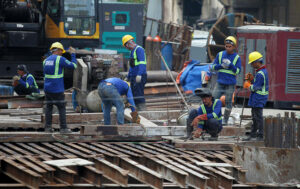By Bernadette Therese M. Gadon, Researcher
BULK prices of construction materials in the capital region decreased by 5.7% year on year in August, the Philippine Statistics Authority (PSA) reported on Friday.
Analysts attributed this to favorable base effects, the global economic slowdown, and the high-interest rate environment.
Preliminary data from the construction materials wholesale price index (CMWPI) in the National Capital Region (NCR) showed that prices were lower compared to the 7% figure in August last year. In July, CMWPI increased by a revised 5.7% annually.
This was the slowest growth in more than a year, or since the 5.2% recorded in February 2022.
Year to date, CMWPI averaged 7.1%.
Commodities that saw slower year-on-year growth rates were fuels and lubricants (-6.6% this year compared to 30.3% a year ago), PVC pipes (-5.1% from 9.8%), and reinforcing and structural steel (3.5% from 10.7%).
Meanwhile, G.I. sheet registered a growth of 12.8% to 16.4% in August this year, up from 3.6% a year ago.
Following that were painting works (10.3% from 7.1%) and doors, jambs, and steel casement (5.1% from 2.2%).
Out of the 17 commodities monitored by the statistics agency, 10 saw slower growth.
Retail prices, tracked by the PSA’s construction materials retail price index (CMRPI), also decreased by 1.4% year on year, down from 6.9%.
This was the slowest growth recorded in more than two years, matching the 1.4% figure from July 2021, and the slowest since the 1.2% in June 2021.
Over the first eight months of the year, CMRPI averaged 3.1%.
The following commodities recorded slower growth rates: miscellaneous construction (-0.7% in August 2023, down from 10.9% in August 2022), tinsmithry (2.9% from 9%), and plumbing (0.4% from 7.5%).
The easing trend seen in the past few months as world prices of most base metals slipped on the risk of US economic slowdown and softer economic data seen in China also contributed to slower price inflation of construction, according to Rizal Commercial Banking Corp. chief economist Michael L. Ricafort.
“Higher interest rates in the US/globally and locally, after the aggressive Fed rate hikes… effectively increased borrowing/financing costs, thereby leading the slower investments and demand for construction materials,” he said in an e-mail.
The weak outlook on the real estate sector also dampened demand for construction materials, according to China Banking Corp. (China Bank) chief economist Domini S. Velasquez,
“Moving forward, however, we may see an uptick in wholesale prices due to the continued increase in global oil prices, which will likely be passed through to retail prices,” she said in a Viber message.
In the coming months, Mr. Ricafort said that the dollar-peso exchange rate may affect import costs on construction materials; however, the continued increase in infrastructure spending, which accounts for at least 5-6% of gross domestic product (GDP), could support demand for construction materials for the rest of the year.
To recall, second-quarter GDP eased further to 4.3% from 6.4% in the first quarter and from 7.5% in the same quarter a year ago due to government underspending and a lack of election-related spending.
Slower global economic growth likewise dragged down the country’s economic performance.
However, the latest data from the Department of Budget and Management showed infrastructure expenditures reached P507.2 billion in the first half of the year, above the P483.1 billion spending program planned for the period.
“The further reopening of the economy towards greater normalcy, with the final lifting of the COVID state of public health emergency since July 22, 2023, could lead to some pick up in construction and other business/economic activities, thereby could also support demand for construction materials,” Mr. Ricafort said.
“Dry weather due to El Nino conditions expected in [the fourth quarter] will also boost construction activity. On the other hand, downward pressure on prices will likely still come from weak real estate demand from high-interest rates,” China Bank’s Ms. Velasquez said.
